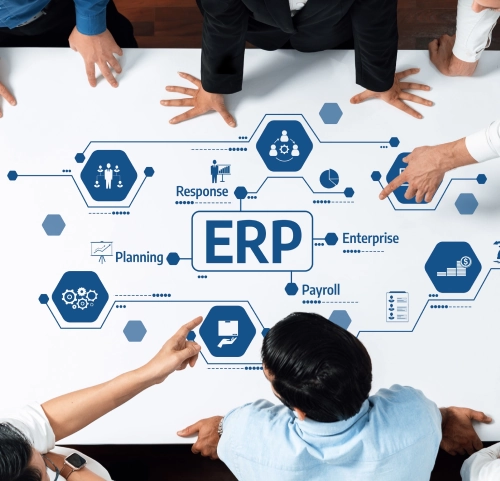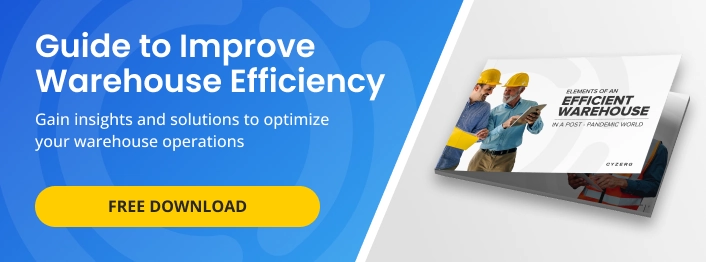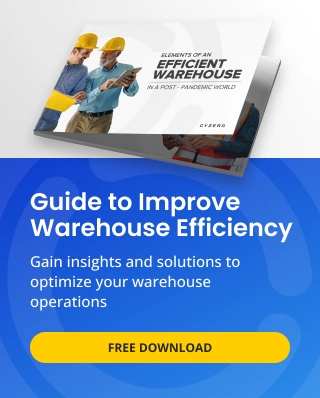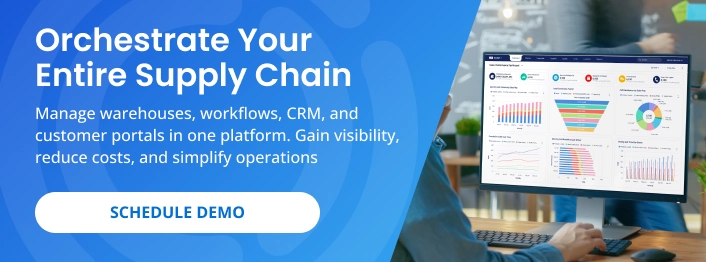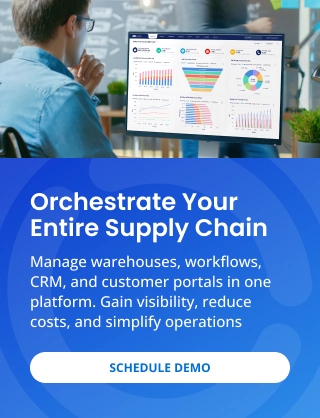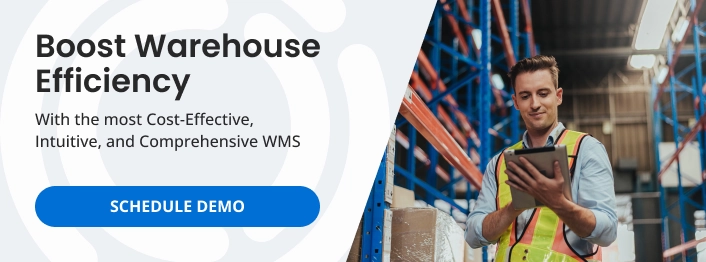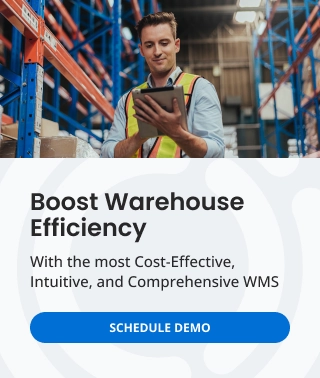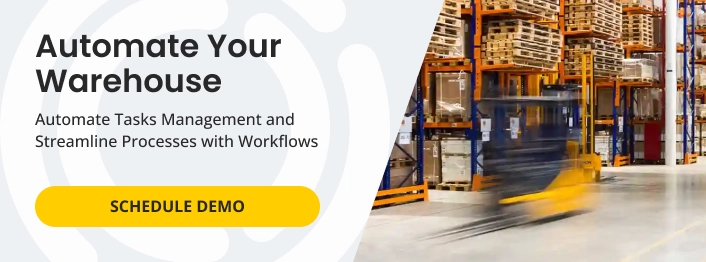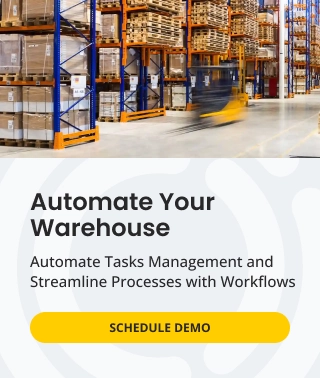Unlike traditional systems such as WMS, TMS, or CRM, which operate in isolation, a modern modern ERP platform connects every part of the business. From procurement and inventory control to production, fulfillment, and customer management, it synchronizes data across departments to eliminate silos and drive efficiency.
According to recent research, more than 50% of organizations are now modernizing their ERP systems to improve agility and decision-making. The rise of cloud-based Enterprise Resource Planning logistics software has made these advanced capabilities accessible even to small and midsized companies—allowing them to compete with larger enterprises while keeping costs low.
In this blog, we’ll explore what an ERP for supply chain management system is, the key features that make it essential for modern logistics, and how solutions like Supply Chain Orchestrator are redefining how companies manage their operations from end to end.
What Is an ERP Supply Chain System?
An ERP supply chain system is an integrated software platform that connects every process involved in supply chain management (SCM), helping companies coordinate procurement, production, and distribution through a unified environment. ERP stands for Enterprise Resource Planning. When combined with supply chain management, it creates a unified environment where information flows smoothly between departments.
From Fragmented Tools to Unified Operations
Traditionally, companies used separate systems to manage warehouse operations, transportation, accounting, and customer relationships. These disconnected tools often created data silos, leading to duplication, delays, and inefficiencies.
In contrast, a supply chain ERP system removes those barriers by consolidating all business functions into one centralized platform. As a result, teams can access real-time data, collaborate more effectively, and make faster, data-driven decisions.
Core Components of a Supply Chain ERP System
At its core, an integrated supply chain platform platform unites the key areas of a supply chain, including:
- Procurement: Manages supplier relationships and purchase orders.
- Inventory Management: Tracking stock levels and raw materials in real time across multiple locations.
- Warehouse Operations: Oversees receiving, storage, picking, and shipping.
- Order Management: Streamlines the order process from entry to fulfillment.
- Accounting and Finance: Connects operational data to costs, billing, and profitability.
- Reporting and Analytics: Delivers real-time insights and performance tracking.
A Single Source of Truth
This unified approach helps companies manage complex operations from a single system. For example, when a product is sold, the inventory count updates automatically, and finance teams see the transaction instantly. Additionally, managers gain full visibility across every department, improving accuracy and collaboration.
In short, ERP logistics software replaces fragmented tools with an integrated platform that offers one source of truth. Every team can rely on the same accurate, real-time information to drive better results.
Key Features of Modern Supply Chain Systems
Modern ERP platform systems have evolved far beyond simple data management tools. They now serve as intelligent platforms that automate, connect, and optimize every link in the supply chain. Below are the most essential features that define today’s leading systems.
Real-Time Visibility Across Operations
One of the biggest advantages of an ERP supply chain solution is real-time visibility. Teams can see inventory levels, order statuses, and production updates instantly. As a result, decisions become faster and more accurate.
Modern platforms—such as Supply Chain Orchestrator—offer live dashboards that track performance and highlight exceptions in real time. This transparency allows managers to act before small issues escalate into costly disruptions.
Integrated Warehouse and Inventory Management
An effective integrated logistics platform system centralizes warehouse and inventory control. It synchronizes stock across multiple locations and automates tasks such as receiving, picking, and shipping.
Advanced systems combine warehouse and inventory modules to ensure accurate order fulfillment and minimize human error. Additionally, these modules connect seamlessly with CRM and workflow tools to create a single operational ecosystem.
Workflow Automation and Process Standardization
Automation is another defining feature of modern ERP solutions. By streamlining business processes, Automated workflows remove repetitive tasks, enforce consistency, and increase team productivity.
For example, systems can automate approvals, task assignments, notifications, and follow-ups—ensuring that purchase orders, shipments, and billing events occur on time and without manual delays. As a result, teams can focus more on strategy and customer service rather than administration.
Advanced Reporting and Analytics
Modern ERP software goes far beyond basic reporting. It offers real-time analytics, predictive insights, and visual dashboards that help leaders anticipate challenges and plan ahead.
What truly sets next-generation systems apart is reporting flexibility. Advanced platforms allow users to build custom reports from any dataset in the system—whether it’s orders, inventory, shipments, or financial data. With just a few clicks, teams can design dashboards that visualize performance in the exact way they need.
This capability, available in Supply Chain Orchestrator, eliminates the dependency on developers or IT staff to extract insights. As a result, business leaders gain faster access to critical data, enabling them to identify trends, correct inefficiencies, and make smarter, data-driven decisions.
Seamless Integration with Other Systems
A powerful enterprise supply chain solution platform connects easily with accounting, CRM, transportation, and customer-facing systems. These integrations ensure that data flows smoothly across all areas of the business.
Modern ERP solutions are built with open integration frameworks that simplify connectivity between logistics operations, financial systems, and external applications. This flexibility allows companies to eliminate manual data transfers and maintain a single, unified source of truth across their entire technology ecosystem.
The Bottom Line
Today’s ERP systems are built for agility, accuracy, and efficiency. They centralize every process—from procurement to delivery—while reducing manual work and data duplication.
By combining essential capabilities such as warehouse management, workflows, analytics, and system integrations, Supply Chain Orchestrator represents how modern ERP technology can simplify even the most complex operations.
Benefits of Using an ERP System
Implementing an ERP system delivers measurable improvements across every area of operations. By unifying data, automating processes, and improving visibility, companies can operate with greater precision, agility, and confidence.
Improved Efficiency and Productivity
An integrated supply chain platform automates manual tasks and streamlines complex workflows. As a result, teams spend less time managing spreadsheets and more time focusing on strategy and customer needs.
For example, automated order processing, inventory updates, and approval workflows eliminate human error while accelerating response times. These efficiencies lead directly to higher throughput and faster fulfillment cycles.
Real-Time Decision-Making
Because all operational data lives within a single platform, leaders gain instant visibility into performance metrics. They can monitor inventory levels, shipment statuses, and production schedules in real time.
With this information, managers can identify bottlenecks, anticipate supply chain disruptions, and make proactive adjustments—rather than reacting to problems after they occur.
Reduced Operational Costs
Automation and visibility together help reduce costs by eliminating waste and inefficiency. Companies save on labor costs, avoid stockouts and overstocking, and cut down on administrative overhead.
In addition, accurate data prevents duplicate work and minimizes costly delays between departments. Over time, these improvements translate into a more agile and cost-effective operation.
Enhanced Collaboration and Communication
Integrated logistics platforms unify departments that once worked in isolation. Procurement, warehouse, accounting, and sales teams now share the same real-time information.
This level of transparency improves coordination, accountability, and trust across the organization. Everyone—from floor staff to executives—works toward the same goals using the same accurate data.
Scalability for Growth
Modern logistics management platform are built to grow with the business. Companies can easily add new modules, integrate with third-party applications, or expand into new locations without replacing their core system.
This flexibility ensures that as customer demands evolve, the technology can adapt—supporting long-term growth and continuous improvement.
ERP vs. Traditional Supply Chain Software
For many years, companies have relied on traditional supply chain systems such as WMS, TMS, and CRM to manage operations. Each tool serves a specific purpose—one handles inventory, another manages transportation, and a third tracks customer data. However, while these systems can perform well individually, they often struggle to work together efficiently.
The Problem with Fragmented Systems
Traditional supply chain software often creates silos between departments. As a result, data must be entered multiple times across different platforms, increasing the risk of errors and delays. In many cases, managers spend hours reconciling data just to understand what’s happening across their operations.
Furthermore, disconnected systems make it difficult to react quickly to changes in demand or supply. For instance, if warehouse inventory isn’t synced with order data, sales teams might promise products that are already out of stock. Ultimately, this leads to missed opportunities, dissatisfied customers, and higher costs.
The Advantage of an Integrated Supply Chain Platform
An ERP logistics platform, on the other hand, eliminates these inefficiencies by connecting every process within a single platform. Consequently, information flows seamlessly from procurement to delivery, ensuring that all departments work from the same set of accurate data.
This level of integration creates what many experts call a “single source of truth.” When an order is placed, the system automatically updates inventory, triggers warehouse activities, and adjusts financial records—all without manual input. As a result, companies gain real-time visibility, reduce communication gaps, and improve coordination throughout their operations.
Transitioning to the Modern Era
Today’s market demands flexibility, speed, and precision—qualities that older systems rarely deliver. Therefore, more organizations are adopting modern ERP platforms that combine automation, predictive analytics, and scalability in one ecosystem.
By transitioning from fragmented software to a connected ERP environment, businesses can operate more efficiently and respond faster to market changes. In the end, those that embrace integration position themselves for long-term growth, agility, and resilience.
Why Traditional ERP Systems Fail Small and Mid-Sized Companies
Traditional ERP systems were originally built for large enterprises with big budgets, extensive IT teams, and complex operations. However, as small and mid-sized businesses began adopting these solutions, many discovered that the traditional model created more problems than it solved.
High Costs and Long Implementation Times
Conventional ERP platforms often require significant upfront investments. In addition, the setup process can take months—sometimes even years—before the system becomes fully operational.
As a result, smaller companies end up allocating limited resources to customization, licenses, and consulting fees rather than using those funds to improve operations. Over time, these costs make traditional ERP systems unsustainable for growing businesses.
Complexity That Slows Teams Down
Older ERP systems are usually large, rigid, and difficult to adapt. Because of this, employees must navigate complicated menus and workflows for even simple tasks. Consequently, productivity decreases, and teams often revert to using spreadsheets to get things done faster.
Furthermore, customizing these legacy systems is rarely straightforward. Every modification requires technical expertise or external support, which adds cost and slows progress.
Limited Flexibility and Scalability
In today’s fast-moving logistics environment, companies need technology that evolves with them. Unfortunately, traditional ERP systems struggle to scale quickly or integrate with new tools.
For example, adding new modules, connecting to third-party applications, or expanding into new markets often requires expensive custom development. In contrast, modern integrated supply chain platforms are designed to scale on demand, offering flexibility without heavy technical barriers.
Lack of Real-Time Insights
Many legacy ERP systems rely on outdated database structures that prevent instant visibility. As a result, decision-makers often operate on stale or incomplete data.
Moreover, because information is stored in multiple disconnected modules, it becomes difficult to analyze performance in real time. This limitation leaves leaders reacting to issues rather than preventing them.
Poor User Experience and Adoption
Even when traditional ERP systems are implemented successfully, adoption rates are often low. That’s because the interfaces are outdated, non-intuitive, and hard to navigate.
Ultimately, users become frustrated, data entry errors increase, and the company never fully benefits from its investment.
The Need for a Modern Alternative
Given these challenges, small and mid-sized businesses increasingly seek solutions that deliver ERP-level functionality without the complexity or high cost. Modern ERP supply chain platforms fill that gap by providing cloud-based access, flexible integrations, and faster implementation times.
In short, the new generation of ERP systems is built for agility—helping growing companies compete on the same playing field as large enterprises, but without the heavy overhead.
Cloud-Based ERP Supply Chain Systems — The Modern Alternative
Technology has transformed the way companies manage their supply chains. Cloud-based ERP supply chain systems now deliver capabilities that were once limited to large, expensive on-premise platforms. As a result, businesses of every size can access real-time data, automation, and scalability without the high upfront cost or complex IT infrastructure.
Lower Costs and Faster Implementation
Unlike traditional ERP software that requires servers, licensing, and maintenance, cloud-based platforms follow a subscription model. Therefore, companies only pay for what they use, and implementation times are dramatically shorter. Many small and midsized businesses can go live within weeks rather than months.
Furthermore, the cost of ownership remains predictable since updates, backups, and support are handled automatically by the provider. This simplicity allows growing companies to focus on operations instead of managing technology.
Modern, Intuitive User Experience
One of the most overlooked advantages of today’s integrated supply chain platforms is their user-friendly design. Unlike older platforms that required extensive training, modern systems focus on clear navigation, visual dashboards, and streamlined workflows.
Because the interface feels intuitive, employees adopt the system faster and use it more effectively. As a result, companies see quicker ROI, higher data accuracy, and stronger collaboration between departments.
Modern interfaces also make it easier for managers to track KPIs, analyze trends, and take action without needing deep technical expertise.
Flexibility and Seamless Integration
Modern integrated logistics platforms are built to integrate easily with existing tools and third-party applications. For instance, they can connect warehouse systems, accounting software, and customer portals without the need for custom development.
This flexibility ensures that as the business evolves, the technology evolves with it. Platforms like Supply Chain Orchestrator embody this principle—offering a modular design that adapts to each company’s size and workflow. Consequently, organizations can start with core modules and scale effortlessly as new needs arise.
Accessibility and Real-Time Collaboration
Because these modern ERP systems run in the cloud, teams can access critical information anytime, anywhere. Warehouse staff, procurement specialists, and managers can all log into the same system simultaneously. In addition, updates made in one department appear instantly across all others. This accessibility fosters transparency, improves collaboration, and speeds up decision-making across the entire operation.
Continuous Improvement and Innovation
Because cloud systems receive regular updates, users always benefit from the latest features, security enhancements, and performance improvements. Moreover, these updates happen automatically, eliminating downtime and extra IT costs.
This continuous evolution keeps businesses competitive and aligned with industry best practices. In contrast, legacy ERP systems often stagnate, forcing companies to pay for expensive upgrades or risk falling behind.
The Bottom Line
Cloud-based ERP supply chain systems have reshaped how companies manage logistics, inventory, and customer relationships. They combine accessibility, automation, and flexibility into one platform that supports growth and efficiency.
By embracing cloud technology, organizations can reduce complexity, improve adoption, and respond faster to market changes. Modern solutions like Supply Chain Orchestrator demonstrate how the future of ERP is not just digital—it’s intuitive, scalable, and designed for people first.
Conclusion: Orchestrating the Future of Supply Chains
The evolution of supply chain technology has made it clear that efficiency depends on connection, visibility, and adaptability. Modern ERP supply chain systems deliver all three—integrating processes, automating workflows, and empowering teams with real-time insights.
Unlike traditional platforms that are rigid and expensive, today’s cloud-based solutions are agile, affordable, and built around user experience. They make advanced supply chain management accessible to every business, regardless of size or technical resources.
As companies continue to face fast-changing market demands, the ability to manage operations from a single, unified platform becomes a true competitive advantage. That’s the foundation of Supply Chain Orchestrator—a modern ERP logistics platform solution designed to simplify complexity, accelerate adoption, and help logistics teams work smarter, not harder.
For organizations ready to modernize their supply chain, the path forward is clear: embrace integrated, cloud-based technology that grows with your business and keeps you ahead of what’s next.
Related Blogs

Cloud Based Inventory Management Systems for Smarter Supply Management
In today’s fast-moving supply chains, businesses need more than traditional tools to stay competitive. Cloud based inventory management systems are becoming essential for companies looking to modernize their operation...
Start Reading

Supply Chain Integration: Strategies, Benefits, and SaaS Solutions
In today’s fast-moving markets, supply chain integration is no longer optional—it’s essential. Businesses depend on smooth coordination between warehouses, transportation, suppliers, and customers to stay competitive....
Start Reading

Supply Chain Planning: Building a Smarter, More Resilient Supply Chain
In today’s fast-changing global market, efficient supply chain planning is more than a strategy—it’s a necessity. Companies that fail to anticipate demand, align production, or manage inventory effectively often face ...
Start Reading
